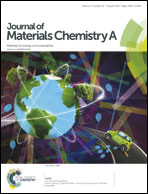High-performance LiMnPO4/C nanoplates synthesized by negative pressure immersion and a solid state reaction using nanoporous Mn2O3 precursors†
Abstract
Preparing high-performance LiMnPO4 is still a large obstacle due to its sluggish electrochemical kinetics. To overcome this problem, a novel method is developed for LiMnPO4/C nanoplates from nanoporous Mn2O3 precursors. There are two advantages. Firstly, through negative pressure immersion, lithium dihydrogen phosphate (LiH2PO4), lithium hydroxide (LiOH) and sucrose (C12H22O11) are deposited on the surface of porous Mn2O3 nanosheets. In the following solid-state reaction, three dimensional continuous conductive carbon is wrapped uniformly around the LiMnPO4/C nanoplates, which greatly improved the conductivity. Secondly, (010) exposed facets are obtained using the Mn2O3 hierarchical microspheres as precursors, which allows for a fast transmission of Li+ ions improving the rate capability. As a result, the as-synthesized L-Mn2O3-LMP/C samples exhibit a superior rate performance with discharge capacities of 157.3 mA h g−1 at C/20, 122.6 mA h g−1 at 1C, and 105.8 mA h g−1 at 2C. Meanwhile, they can retain 99.3% of the initial capacity after 100 cycles at 1C, revealing an excellent cycling stability. This method sheds more light on the fabrication of high-performance LiMnPO4/C cathode materials and is suitable for large scale productions.


 Please wait while we load your content...
Please wait while we load your content...